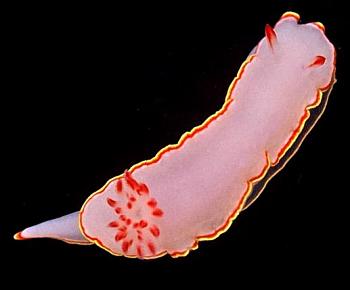
Glossodoris sedna
(Marcus & Marcus, 1967)
Order: NUDIBRANCHIA
Suborder: DORIDINA
Superfamily: EUDORIDOIDEA
Family: Chromodorididae
DISTRIBUTION
Tropical East Pacific from Mexico to Galapagos Ids. Records from tropical West Atlantic [Florida, Bahamas] considered the result of shipping.
PHOTO
Shallow subtidal off Isla Luz, Bahia de Concepcion, Sea of Cortez, Mexico. February, 1992. Photo: Jeff Goddard.
Body and mantle translucent white with both foot and mantle bordered with three colour bands: an inner opaque white, then red and an outer yellow band. The upper half of the rhinophore clubs and the tips of the gills are red.
Reference:
• Bertsch, H. (1978). The Chromodoridinae Nudibranchs from the Pacific Coast of America – Part III. The genus Chromolaichma and Mexichromis. The Veliger, 21 (1): 70-86.
• Bertsch, H. 1988. Anatomy and Zoogeography of Glossodoris sedna and Chromodoris grahami (Opisthobranchia: Nudibranchia) in the Tropical Western Atlantic and Caribbean. The Veliger, 30(4): 395-399.
• Lyons, W. G. 1989. Atlantic records of Glossodoris sedna (Gastropoda: Nudibranchia): A Correction. The Veliger, 32(4): 412.
See Jeff Goddard's message.
Authorship detailsRudman, W.B., 2000 (October 10) Glossodoris sedna (Marcus & Marcus, 1967). [In] Sea Slug Forum. Australian Museum, Sydney. Available from http://www.seaslugforum.net/find/glossedn
Related messages
Glossodoris sedna from Belize
October 3, 2007
From: Robert Lee
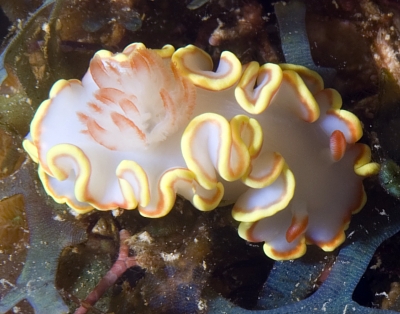
Hi Bill,
Just got back from Belize where I saw my first Caribbean nudibranch. Hope this adds a piece to the Atlantic range puzzle for the species.
Locality: San Pedro, 10m, Ambergris Caye, Belize, Atlantic Ocean, 28 September 2007, coral reef. Length: 3 cm. Photographer: Robert Lee.
Robert Lee
robert.h.lee@oracle.com
Lee, R.H, 2007 (Oct 3) Glossodoris sedna from Belize. [Message in] Sea Slug Forum. Australian Museum, Sydney. Available from http://www.seaslugforum.net/find/20876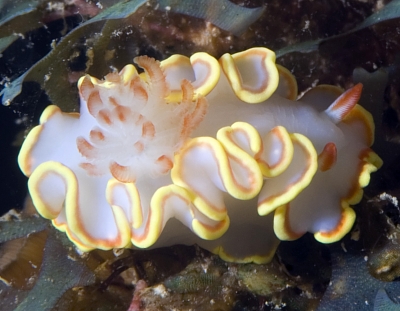
Thanks Rob,
Every little bit of information helps. I see Caribbean Sea Slugs records it from Belize, so your record and others on the Forum from Honduras and the Turks and Caicos Ids certainly suggests a very wide distribution in the eastern Caribbean. Perhaps G. sedna will turn out to be one of the species with a natural distribution on both sides of the Panama Isthmus rather than a recent introduction into the Caribbean from the east Pacific.
Best wishes,
Bill Rudman
Glossodoris sedna from Costa Rica
June 22, 2007
From: Russel Schoenhard
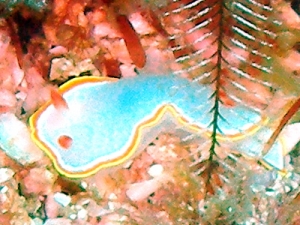
Dear Dr. Rudman,
I came across this specimen while diving in the Guanacaste region on the Pacific Coast of Costa Rica. I just recently discovered the Sea Slug Forum and have found it to be very help and informative.
Locality: Playa del Carmen, 10-15m, Guanacaste, Costa Rica, Pacific Ocean, 26 March 2007, Rocky reef. Length: less than 1 inch. Photographer: Russel Schoenhard.
Thanks in advance for your help.
Russel Schoenhard
russelschoenhard@gmail.com
Schoenhard, R., 2007 (Jun 22) Glossodoris sedna from Costa Rica. [Message in] Sea Slug Forum. Australian Museum, Sydney. Available from http://www.seaslugforum.net/find/20006Dear Russel,
This is Glossodoris sedna. It was first found on the Pacific Coast of tropical America and now has been found in parts of the Caribbean. This poses the interesting question of whether this species was a Pacific coast animal which has been moved to the Caribbean by human intervention, perhaps as ballast water in shipping, or whether it is one of those species which occupied both regions before the Panama Isthmus was formed.
Best wishes,
Bill Rudman
Re: Glossodoris sedna from Turks and Caicos
July 1, 2006
From: Florent Charpin
Concerning message #17015:
Dear Bill,
To answer your question in message #17015, the Glossodoris sedna in the upper photo was indeed found on the blackish sponge, it was not moved at all.
Best regards,
Florent
florent1@gmail.com
Charpin, F., 2006 (Jul 1) Re: Glossodoris sedna from Turks and Caicos. [Message in] Sea Slug Forum. Australian Museum, Sydney. Available from http://www.seaslugforum.net/find/17031Dear Florent,
Thanks for the confirmation. I'll try and get the sponge identified.
Best wishes,
Bill Rudman
Glossodoris sedna from Turks and Caicos
June 29, 2006
From: Florent Charpin
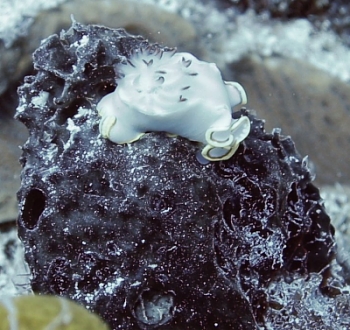
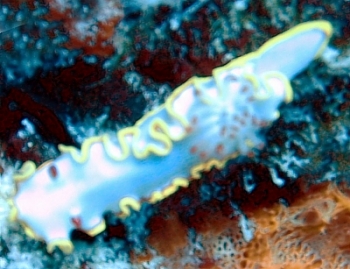
Dear Bill,
After reading in message #15600 about how little is known of the geographical distribution of Glossodoris sedna in the Caribbean I'd like to share with you a sighting of two G. sedna in West Caicos (Turks and Caicos) in January 2005. The two nudibranchs were about one foot apart. Unfortunately the pictures taken are of very poor quality.
Locality: West Caicos, Turks and Caicos, 50 feet, Turks and Caicos, West Atlantic Ocean, 15 January 2005. Photographer: Lucia M. Kim.
Thanks!
Florent
florent1@gmail.com
Charpin, F., 2006 (Jun 29) Glossodoris sedna from Turks and Caicos. [Message in] Sea Slug Forum. Australian Museum, Sydney. Available from http://www.seaslugforum.net/find/17015Dear Florent,
Thanks for this extra piece of information. The animal in the upper photo seems to have lost quite a bit of its mantle skirt around the gills. I would be interested to know if the blackish-grey sponge it is sitting on is where it was found? There is still a bit of a mystery about what sponge or sponges this species eats, so any association with a sponge may prove to be a useful clue.
Best wishes,
Bill Rudman
Re: Glossodoris sedna from Utila, Honduras
January 20, 2006
From: Ray Simpson
Concerning message #15600:
Regarding the message on Glossodoris sedna from Honduras... is it possible that this species is a naturally occurring West Atlantic-East Pacific species? There are numerous species that are found on both sides of Central America, why was it assumed in the first place that this species was an introduction? It seems that if this species was introduced by ballast water it would be restricted to S. Fla. and the Bahamas... I guess you have your suspicions after this recent message?
Going along with the idea, is Glossodoris restricted to the Eastern Pacific? There seems to be 3 species (G. sedna, G. baumanni, G. dalli) in the Eastern Pacific. The Malacolog database indicates that there is a species called Glossodoris moerchi in the Western Atlantic ... is this a valid species or could it be a misidentification of another genus or even G. sedna?
Appreciate your time,
Ray Simpson
P51MustNB@aol.com
Simpson, R., 2006 (Jan 20) Re: Glossodoris sedna from Utila, Honduras. [Message in] Sea Slug Forum. Australian Museum, Sydney. Available from http://www.seaslugforum.net/find/15614Dear Ray,
Certainly we sometimes can't be sure with species which are found in two or more disjunct geographic areas. You will see I have often discussed how difficult it is to know where some well-known hitchhikers, such as Thecacera pennigera originated. Of course others such as the lessepsian migrants are usually obvious because we know the fauna of the Mediterranean quite well.
You are of course right when you say there are species which occur naturally on both sides of the Panama Isthmus, but this does mean that all species found on both sides are naturally occurring. I guess G. sedna is considered 'native' to the east Pacific because it was first found there and has quite a wide distribution there. While G. sedna had just a limited distribution in the Florida - Bahamas region it was reasonable to assume it was an import, but the Honduras record suggests it is either spreading or perhaps may have a much wider Caribbean distribution, which could either be natural or from human intervention.
There is at least one Glossodoris in the Atlantic, G. ghanensis, but it hasn't to my knowledge reached the west Atlantic. Concerning Glossodoris moerchi. Web-based databases can be a trap as they are usually not well edited or updated. That species was originally described as Goniodoris picturata by Moerch - a preoccupied name which was later changed to Chromodoris moerchi by Bergh. The generic names in the chromodorids became terribly confused for about a hundred years and at one stage almost everything was placed in Glossodoris. Whatever its correct genus placing, the original description is not good enough to be sure what Moerch was talking about.
So to wrap up, I guess it pays to keep an open mind on some of these distributions. With our present state of knowledge it seems logical to consider G. sedna to be native to the East Pacific only, but we just don't know how good our knowledge is.
Best wishes,
Bill Rudman
Glossodoris sedna near La Paz, Sea of Cortez
January 20, 2006
From: Renee Gallo
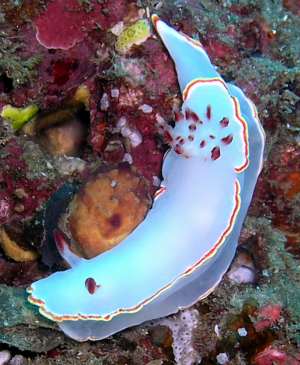
Hi Bill,
In a recent post from Jack Connick [#15507] you mentioned that you don't have as many pictures of Glossodoris sedna in the Pacific. I hope this may be of use. It's a beautiful little slug.
Locality: La Reinita, near La Paz, Baja California Sur, Mexico. Sea of Cortez. Depth: 20-30 feet. Length: 1-3 inches. 21 August 2005. rocky reef
Photographer: Renee Gallo
Renee Gallo
rgallo@mail.com
Renee Gallo, 2006 (Jan 20) Glossodoris sedna near La Paz, Sea of Cortez. [Message in] Sea Slug Forum. Australian Museum, Sydney. Available from http://www.seaslugforum.net/find/15606Thanks Renee,
By coincidence, I just posted a photo yesterday of this animal from Honduras - another one from the other side.
Best wishes,
Bill Rudman
Glossodoris sedna from Utila, Honduras
January 19, 2006
From: Les Wilk
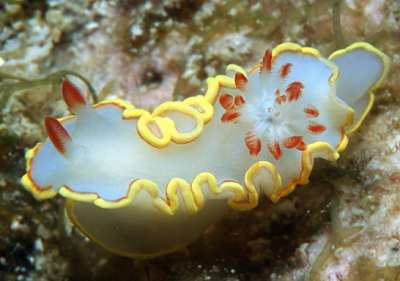
Hi Bill;
Just letting you know that the tropical West Atlantic range of Glossodoris sedna includes the island of Utila, Honduras.
Locality: Utila Island, Honduras. Caribbean. Depth: 30 feet. Length: 1 inch.
July 2000. reef. Photographer: Keri Wilk
Les Wilk
wilk@reefnet.ca
Wilk, L., 2006 (Jan 19) Glossodoris sedna from Utila, Honduras. [Message in] Sea Slug Forum. Australian Museum, Sydney. Available from http://www.seaslugforum.net/find/15600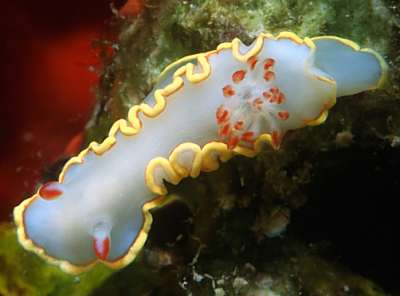
Thanks Les,
I think this is an interesting expansion to its known Caribbean distribution. Humann & Deloach (2002) note that it is known f rom Sth Florida and the NE Bahamas. Their suggestion that it may have got through the Panama Canal on a ship's bottom ignores the fresh water lakes that form part of the canal system, though this doesn't preclude their other suggestion that it may have arrived in ballast water.
Best wishes,
Bill Rudman
Glossodoris sedna from Revillagigedos Islands, Mexico
January 10, 2006
From: Jack Connick
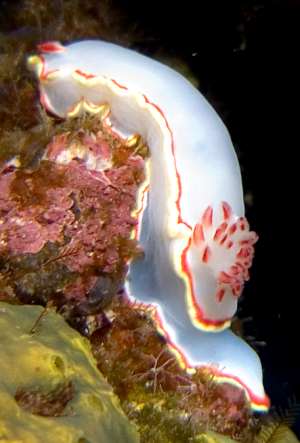
Hi Bill;
Thought you might like this shot of a Red-tipped Dorid, Glossodoris sedna for your collection.
Locality: El Boiler, San Benedicto Island, Revillagigedos Islands, Baja California, Mexico. Pacific Ocean. Depth: 50 feet. Length: 4". 11 November 2005. small opening on a steep rocky sea mount. Photographer: Jack Connick
It was taken in a very remote location in the Revillagigedos Islands, 325 miles offshore from Baja California, Mexico. I think most of the shots you have are from the mainland.
There were many of these about, but no other "slugs" we could find.
Jack Connick
JackConnick@Yahoo.com
Connick, Jack, 2006 (Jan 10) Glossodoris sedna from Revillagigedos Islands, Mexico. [Message in] Sea Slug Forum. Australian Museum, Sydney. Available from http://www.seaslugforum.net/find/15507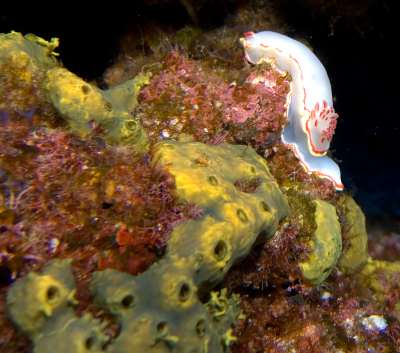
Thanks Jack,
In fact most of the photos we have of this species are from the Florida population. If you saw quite a few specimens, is there any possibility you took a photo of one feeding. Although there is a yellow sponge in your photos, it doesn't look like it belomge to a family favoured by chromodorids.
Best wishes,
Bill Rudman
Re: Glossodoris sedna in Florida again
February 25, 2005
From: Blair Carmichael
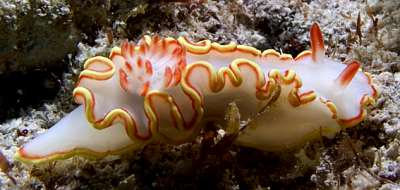
My girlfriend and I were diving the Southern Key Largo area in February 2005. The dive spot was called "Snapper ledge" in 30-40 feet we found 2 new slugs. At first I was unable to identify them. Of course I took lots of photos, and I would look them up later. They weren't listed in my dive books for the Keys.
Locality: Key Largo, Florida, USA. Depth: 35 feet. Length: 35+ mm. 14 February 2005. Snapper Ledge reef. Photographer: Blair Carmichael
Thanks to the Sea Slug Forum we discovered they were Glossodoris sedna, and put an end to the mystery. Reading about them it might be even more of a mystery now.
Thanks,
Blair
Blaircarmichael@yahoo.com
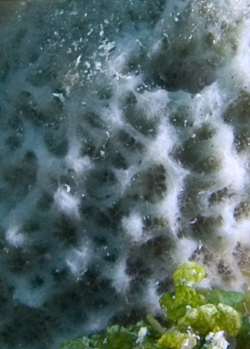
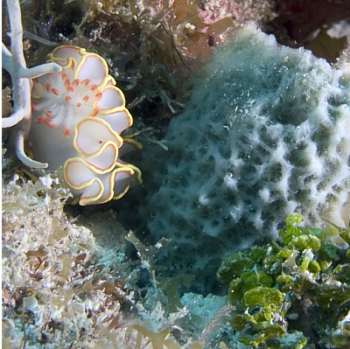
Dear Blair,
Thanks for the photos. What is particularly exciting is that one of your animals seems to be eating the bluish sponge in your lower photo. As far as I can find no one has reported on the sponge choice of this species, either in the Caribbean or its 'real' home, the East Pacific. I'll have to get its identity checked, but it shopuldn't be too difficult from your photo.
Best wishes,
Bill Rudman
Glossodoris sedna from Galapagos Ids
January 3, 2005
From: Julianne Parolisi
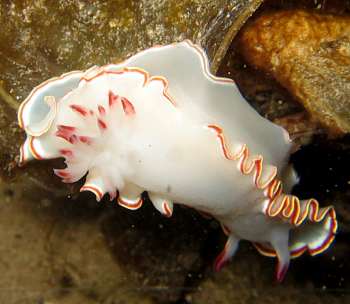
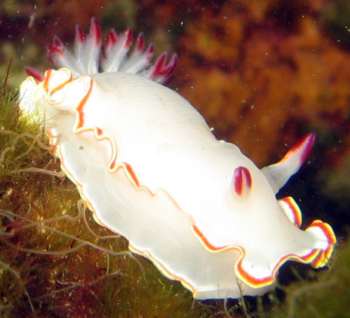
Hi again Bill, and happy new year!
Thank you for your response to my message about Glossodoris dalli. You mentioned that you'd love to see more photos from the Galapagos, so here are some I happen to have of Glossodoris sedna and in a separate message one of the endemic Tambja mullineri. Unfortunately I don't have any of feeding or mating behaviours though.
Locality: Isabela Island, Galapagos Ids, Ecuador, east Pacific Ocean
Depth: ~3 meters. Length: ~ 1 inch. 4 December 2004. Photographer: Julianne Parolisi
Finding your website has sent me on a sea slug frenzy and I've been doing lots of research-- I had no idea there was such a slug "scene" out there! I would love to get more involved, whether in research or photography, or anything else (if you have any ideas on where to start, please let me know!). I find these creatures absolutely amazing and am dying to find out everything I can about them :)
Wishing you lots of beautiful nudibranchs for 2005,
Julianne
aurorable@gmail.com
Parolisi, J., 2005 (Jan 3) Glossodoris sedna from Galapagos Ids. [Message in] Sea Slug Forum. Australian Museum, Sydney. Available from http://www.seaslugforum.net/find/12870Dear Julianne,
Thanks for these photos of G. sedna. It would certainly be nice to see photos of this on its food sponge, which we don't know, and photos of its egg ribbon. I certainly look forward to hearing about more of your discoveries
Best wishes,
Bill Rudman
Re: Glossodoris sedna from Florida
July 13, 2004
From: Dave Behrens
Bill:
In reponse to your comments [m12688]
Jeff Hamann and I collected Glossodoris sedna many years back at Big River in southern Belize. Our specimen was very large for this species. As I recall it was nearly 7 cm. On the Pacific side, specimens generally smaller. Caribbean occurrences seem to be of individuals, whereas on the Pacific side the side is quite gregarious, commonly being found in numbers.
Dave Behrens
dave@seachallengers.com
Behrens, D., 2004 (Jul 13) Re: Glossodoris sedna from Florida. [Message in] Sea Slug Forum. Australian Museum, Sydney. Available from http://www.seaslugforum.net/find/12690Thanks Dave,
Bill Rudman
Glossodoris sedna from Florida
July 12, 2004
From: Jim Lyle
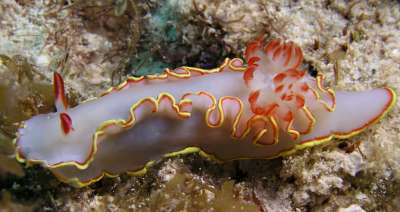
Dr. Rudman:
I'm sending you this picture of Glossodoris sedna that we observed on a dive in Key Largo, Florida. Although a Pacific Ocean species, this species has been reported from Biscayne Bay and the Bahamas. This was the only specimen that we observed. It was in 25 feet of seawater on Molasses Reef.
Best,
Jim Lyle
jlyle@adelphia.net
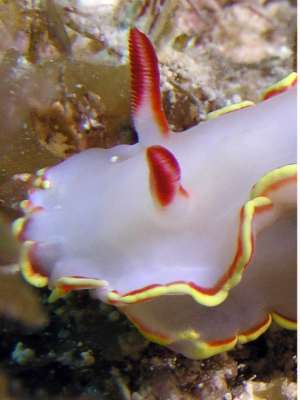
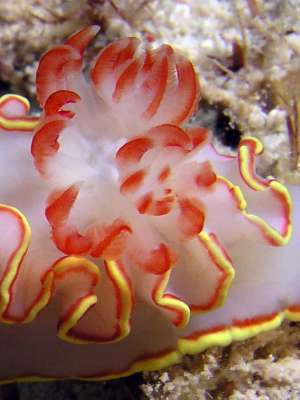
Thanks Jim,
We now have quite a few records of this species from Florida. It will be interesting to see if it appears elsewhere in the Caribbean. If its presence in Florida and the Bahamas is the result of human activity it will be, as far as I know, only the second chromodorid that has successfully established itself outside its natural range. The other one is the lessepsian migrant, Hypselodoris infucata, and Indo-West pacific species found regularly in the eastern Mediterranean. There are of course some nudibranchs, mainly polycerids, which are well-known 'tramp' species, but they feed on arborescent bryozoans which have become widely distributed on the bottom of boats. Chromodorids are specialist sponge feeders, so for a species to successfully colonise a new geographic area it would need to find a new acceptable sponge food, or its natural food would also need to be present - perhaps also by human intervention - which would be a lucky co-incidence.
Best wishes
Bill Rudman
Glossodoris sedna in Florida again
February 26, 2004
From: Paul Osmond
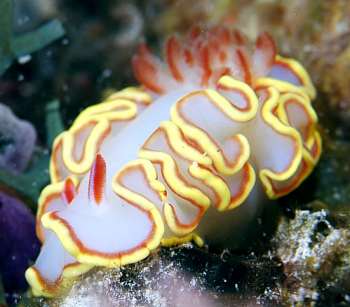
This past weekend [February 2004] in Biscayne National Park [Florida, USA] we once again found Glossodoris sedna - but this time we found a whole bunch of them. 10 individuals were spotted in a small area in about 3 meters (10 feet) of water and another diver reported also seeing other individuals on the same dive in a separate location. The images included are all of separate individuals found on 2 adjacent coral heads.
This is the third sighting of this species for me in the park and sixth sighting overall in Florida. At no time have I seen an individual on anything but algae covered rocks - I suspect that the species is eating the algae itself (or something on the algae) that is shown in several images of the species. For Florida where nudibranchs are not abundent in great numbers, 10 specimans is a herd, so the species is certainly thriving.
Paul
www.deepseaimages.com
marriard@deepseaimages.com
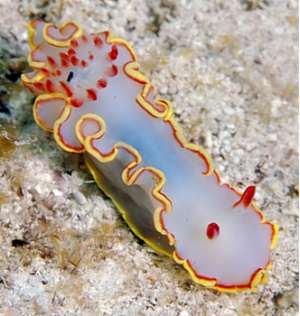
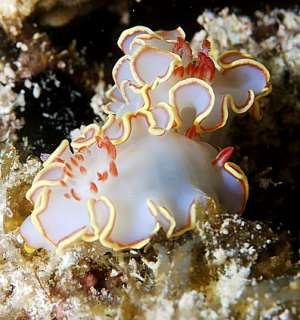
Thanks Paul,
As I said in reply to your earlier message [#10527] all chromodorids are sponge feeders but some seem to feed on sponges which tend to disguise their nature much of the time. By that I mean they seem either unable, to stop other animal colonies and plants from overgrowing them. Or perhaps they allow their colonies to be overgrown as a protection from predation. Whatever the reason there are a number of species, such as Ceratosoma brevicaudatum and Hypselodoris bennetti, which we have had difficulty in discovering their food sponges. But once we do we realise that usually these sponges look just like a piece of rock overgrown with algae.
Certainly when you find a group together it would be worth poking around where they are to see if the 'rock' is soft.
Best wishes
Bill Rudman
Glossodoris sedna from the Sea of Cortez
September 29, 2003
From: Rand McMeins
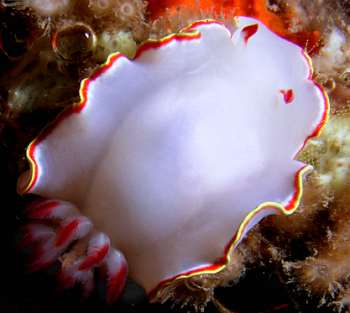
Greetings Bill,
I think this is Glossodoris sedna. Could you confirm please?
Location: Sea of Cortez. [Gul of California]Dive site: Whale Island. North of La Paz. Less than 10' of water feeding on a wall just inside of a Cavern.
Thanks,
Rand
randapex@worldnet.att.net
McMeins, R., 2003 (Sep 29) Glossodoris sedna from the Sea of Cortez. [Message in] Sea Slug Forum. Australian Museum, Sydney. Available from http://www.seaslugforum.net/find/11047Dear Rand,
This is indeed G. sedna. This species was first described from animals collected at Puerto Penasco, at the northern end of the Sea of Cortez, so it's good to see a photo of another specimen from that region, since many on the Forum are of animals from the Florida region where it seems to have been introduced through human activity.
Best wishes,
Bill Rudman
Glossodoris sedna in Key Largo, Florida
August 9, 2003
From: Paul Osmond
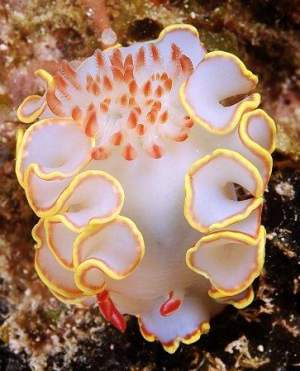
In July we found another Glossodoris sedna on a bed of Sea Grass in the southern most of the reefs in Key Largo, Florida [centre two photos].
I know these are not native to the area so it is interesting to note that this is my second time seeing one in Florida this year. I saw the same species in Biscayne National Park in late March earlier this year [upper right photo].
Since these areas are 50+ miles apart I think it is reasonable to assume there are now several population groups of this Nudibranch in Florida.
Thanks,
Paul
marriard@deepseaimages.com
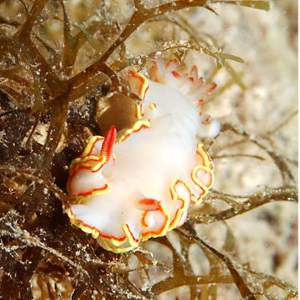
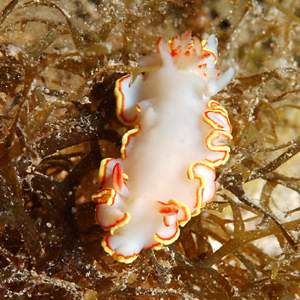
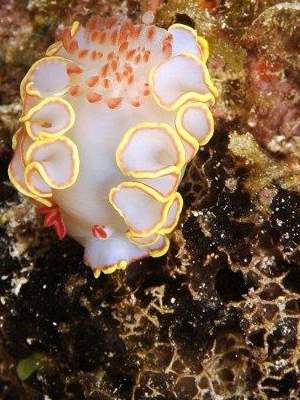
Dear Paul,
Thanks for these photos. They are an interesting addition to our knowledge. I have included another photo of yours from Biscayne National Park [lower right] because it shows to interesting things. Firstly the right rhinophore is present in triplicate - another addition to the abnormality page.
Secondly I suspect the purplish-brown region in the bottom right of the photo is a sponge, and if so, it could be the food of G. sedna. All chromodorids that have been studied have a very specialised diet, eating only one, or a very few species of sponge. The first question that arises when we have an apparent introduction of a species into a new region is what it is eating? Has it found a suitable or local food species to replace its 'real' diet, or has its original food sponge also been introduced into the new region. In this case we don't know what its food is in either the eastern Pacific or the Caribbean so it woudl be interesting to find out
Best wishes,
Bill Rudman
Glossodoris sedna from Florida
May 19, 2003
From: Brian Smith
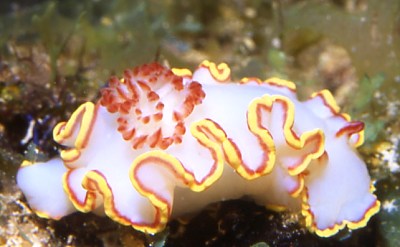
I shot this "critter" a few weeks ago in Key Largo, Florida. I think it's a nudi, but I'm not sure. (I thought the first flatworm I took a picture of whas a nudi!)
I shot this beautiful creature near Tavernier, Key Largo, Florida, USA on April 12, 2003, in less than 30' of water
Thanks,
Brian Smith
Indianapolis, Indiana (NOT the diving capital of the world!)
basmith@wildfire.net
Smith, B., 2003 (May 19) Glossodoris sedna from Florida. [Message in] Sea Slug Forum. Australian Museum, Sydney. Available from http://www.seaslugforum.net/find/9855Dear Brian,
This is a chromodorid nudibranch named Glossodoris sedna. It is quite common on the East Pacific coast of central America and as we have discussed earlier it has been found a few times in Florida and the northern Bahamas and is considered an accidental introduction through shipping from the eastern Pacific.
Best wishes,
Bill Rudman
Glossodoris sedna from the western Atlantic
November 5, 2002
From: Colin Redfern
Dear Bill,
As a footnote to Linda's record of Glossodoris sedna from Florida, there are two more references that clarify the known range of this species in the tropical western Atlantic. Bertsch (1988) examined two specimens from Tavernier Key, and referred to a photographic record from Key Largo, both of which are locations in the Florida Keys. He also referred to a photographic record from Biscayne Bay, Florida, but Lyons (1989) pointed out that the correct location for that record was in less than 1m of water at Green Turtle Cay, Abaco, Bahamas, which is approximately 200 miles north-east of Biscayne Bay. As far as I know, this is the only published record from a location east of the Gulf Stream.
References:
• Bertsch, H. 1988. Anatomy and Zoogeography of Glossodoris sedna and Chromodoris grahami (Opisthobranchia: Nudibranchia) in the Tropical Western Atlantic and Caribbean. The Veliger, 30(4): 395-399.
• Lyons, W. G. 1989. Atlantic records of Glossodoris sedna (Gastropoda: Nudibranchia): A Correction. The Veliger, 32(4): 412.
Best Wishes,
Colin
bahamianseashells@att.net
Redfern, C., 2002 (Nov 5) Glossodoris sedna from the western Atlantic. [Message in] Sea Slug Forum. Australian Museum, Sydney. Available from http://www.seaslugforum.net/find/8356Thanks Colin,
It would certainly be interesting to know if it has turned up anywhere else in the Caribbean region
Best wishes,
Bill Rudman
E. Pacific Glossodoris sedna from Florida
November 4, 2002
From: Linda Ianniello
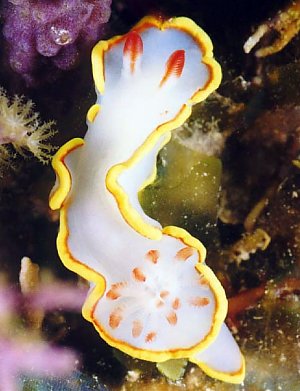
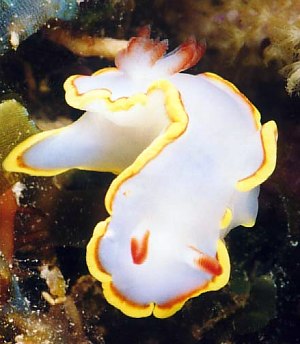
Dr. Bill,
Attached are two photos of Glossodoris sedna from Biscayne Bay, Florida. They were taken in October, 2002, at a depth of about 20 feet. Paul Humann's book states that in this area they are mainly found in Biscayne Bay, and likely came from the Pacific through the Panama Canal on the bottom of a ship or in a ballast tank. We found two on the same dive, both about 1/2 inch.
Regards,
Linda I.
lindai@us.ibm.com
Ianniello, L., 2002 (Nov 4) E. Pacific Glossodoris sedna from Florida. [Message in] Sea Slug Forum. Australian Museum, Sydney. Available from http://www.seaslugforum.net/find/8321Thanks Linda,
This is certainly an interesting record and with Humann's record, seems to suggest there may be a permanent population in at least Florida, if not the whole of the Caribbean.
Best wishes,
Bill Rudman
Re: Glossodoris sedna from Costa Rica
June 16, 2002
From: Alicia Hermosillo
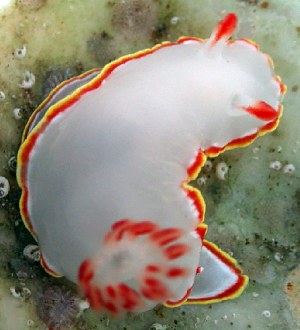
Dear Dr. Rudman,
I agree with Peter's message - Glossodoris sedna is one of the most common and abundant opisthobranchs of the Eastern Pacific (second to Elysia diomedea).
In Bahia de Banderas, Mexico, I see them in almost every dive and dive site and variety of depths through out the year but more abundant yet during winter. They seem to prefer areas where currents are mild to strong.
THis one is from Islas Marietas, Bahia de Banderas, 64 feet deep and 24 mm long.
Alicia Hermosillo
gueri25@hotmail.com
Hermosillo, A., 2002 (Jun 16) Re: Glossodoris sedna from Costa Rica. [Message in] Sea Slug Forum. Australian Museum, Sydney. Available from http://www.seaslugforum.net/find/7236Thanks Alicia,
Its interesting to find out what are the common species in other parts of the world. Does it mean you know what sponges it eats and what sort of egg ribbon it lays? I'm afraid that two of the common species in Sydney, Rostanga arbutus and Hypselodoris bennetti proved to be two of the most difficult to get any information on their natural history. I hope the same 'rule' doesn't apply for you.
Best wishes,
Bill Rudman
Glossodoris sedna from Costa Rica
June 3, 2002
From: Peter Ajtai
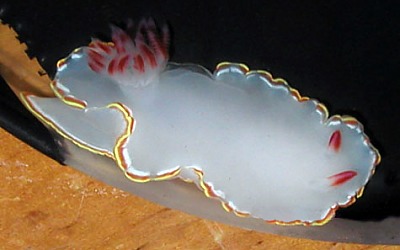
Dear Bill,
Glossodoris sedna seem to be everywhere along the Pacific coast of Costa Rica. The only sea slug I see more often than G. sedna is Elysia diomedea. The photo of G. sedna is from the Islas Murcielago island chain, but they are everywhere along the coast at all diving depths.
Cheers,
Peter Ajtai
ajtai@slugophile.org
Ajtai, P., 2002 (Jun 3) Glossodoris sedna from Costa Rica. [Message in] Sea Slug Forum. Australian Museum, Sydney. Available from http://www.seaslugforum.net/find/7082Thanks Peter,
Bill Rudman
Glossodoris sedna from Mexico
October 13, 2000
From: Jeff Goddard

Dear Bill,
Here is a photo of Glossodoris sedna.
Shallow subtidal off Isla Luz, Bahia de Concepcion, Sea of Cortez, Mexico. February, 1992. Photo: Jeff Goddard.
Best wishes,
Jeff Goddard.
Thanks Jeff,
Bill Rudman
